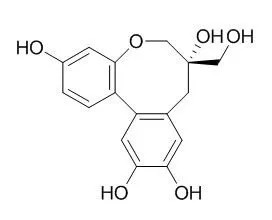| Kinase Assay: |
| Eur J Pharmacol. 2015 Mar 15;751:13-23. | | Protosappanin B protects PC12 cells against oxygen-glucose deprivation-induced neuronal death by maintaining mitochondrial homeostasis via induction of ubiquitin-dependent p53 protein degradation.[Pubmed: 25657114 ] | Protosappanin B (PTB) is a bioactive dibenzoxocin derivative isolated from Caesalpinia sappan L.
METHODS AND RESULTS:
Here, we investigated the neuroprotective effects and the potential mechanisms of Protosappanin B on oxygen-glucose deprivation (OGD)-injured PC12 cells. Results showed that Protosappanin B significantly increased cell viability, inhibited cell apoptosis and up-regulated the expression of growth-associated protein 43 (a marker of neural outgrowth). Moreover, our study revealed that Protosappanin B effectively maintained mitochondrial homeostasis by up-regulation of mitochondrial membrane potential (MMP), inhibition of cytochrome c release from mitochondria and inactivation of mitochondrial caspase-9/3 apoptosis pathway. Further study showed that Protosappanin B significantly promoted cytoplasmic component degradation of p53 protein, a key negative regulator for mitochondrial function, resulting in a release of Bcl-2 from p53-Bcl-2 complex and an enhancing translocation of Bcl-2 to mitochondrial outer membrane. Finally, we found the degradation of p53 protein was induced by Protosappanin B via activation of a MDM2-dependent ubiquitination process.
CONCLUSIONS:
Taken together, our findings provided a new viewpoint of neuronal protection strategy for anoxia and ischemic injury with natural small molecular dibenzoxocin derivative by activating ubiquitin-dependent p53 protein degradation as well as increasing mitochondrial function. | | Biol Pharm Bull. 2007 Jan;30(1):193-6. | | In vitro study for inhibition of NO production about constituents of Sappan Lignum.[Pubmed: 17202686] |
METHODS AND RESULTS:
As it was reported that Brazilin inhibited inducible NO gene, we conducted to similar tests for six known compounds isolated from Sappan Lignum, namely, brazilein, sappanchalcone, protosappanin A, Protosappanin B, protosappanin C besides brazilin. And six compounds were also subjected to six tests to speculate their properties: (1) inhibition of NO production by cultured J774.1 (macrophage-like) cell line, (2) suppression of inducible NO synthase (iNOS) gene expression, (3) inhibition of NO production by murine peritoneal macrophages, (4) DPPH radical scavenging activity, (5) reduction of ferric ion and (6) antioxidant activity. Brazilein and sappanchalcone showed significant inhibition of lipopolysaccharide (LPS)-induced NO production by J774.1 cell line like Brazilin; 100% inhibition at 30 microM in test (1) and at 10 microM in test (3). The mechanisms underlying the inhibition of NO production by the compounds were investigated in test (2). As a result, brazilin was found to almost completely suppress iNOS gene expression at 100 microM as reported, and brazilein and sappanchalcone also suppressed iNOS gene expression. But strong activities were not observed for protosappanins A, B and C. So, we conducted tests (4), (5) and (6) to investigate other properties about six compounds. Protosappanin A and Brazilin demonstrated high antioxidant activity compared with Vitamin E in tests (4) and (5). Protosappanin A and B inhibited the oxidation of linoleic acid in test (6). Among the dibenzoxocin derivatives, only protosappanin C did not show significant activity in all the tests.
CONCLUSIONS:
We found that sappanchalcone showed same activity as brazilin, and six compounds isolated from Sappan Lignum showed various properties. |
|






 Cell. 2018 Jan 11;172(1-2):249-261.e12. doi: 10.1016/j.cell.2017.12.019.IF=36.216(2019)
Cell. 2018 Jan 11;172(1-2):249-261.e12. doi: 10.1016/j.cell.2017.12.019.IF=36.216(2019) Cell Metab. 2020 Mar 3;31(3):534-548.e5. doi: 10.1016/j.cmet.2020.01.002.IF=22.415(2019)
Cell Metab. 2020 Mar 3;31(3):534-548.e5. doi: 10.1016/j.cmet.2020.01.002.IF=22.415(2019) Mol Cell. 2017 Nov 16;68(4):673-685.e6. doi: 10.1016/j.molcel.2017.10.022.IF=14.548(2019)
Mol Cell. 2017 Nov 16;68(4):673-685.e6. doi: 10.1016/j.molcel.2017.10.022.IF=14.548(2019)